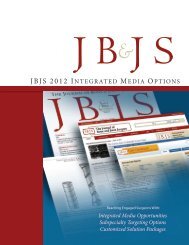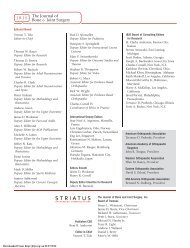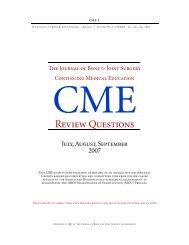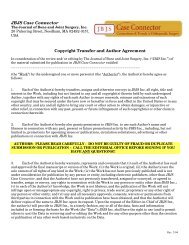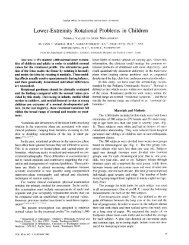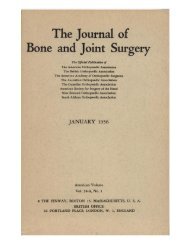Front Matter - The Journal of Bone & Joint Surgery
Front Matter - The Journal of Bone & Joint Surgery
Front Matter - The Journal of Bone & Joint Surgery
Create successful ePaper yourself
Turn your PDF publications into a flip-book with our unique Google optimized e-Paper software.
Adv 64<br />
JBJS [Br] Abstracts Now Available<br />
Trauma<br />
Fractures <strong>of</strong> the distal third <strong>of</strong> the humerus with palsy <strong>of</strong> the radial<br />
nerve<br />
MANAGEMENT USING MINIMALLY-INVASIVE<br />
PERCUTANEOUS PLATE OSTEOSYNTHESIS<br />
A. Livani, W. D. Belangero, and R. Castro de Medeiros<br />
From the State University <strong>of</strong> Campinas, Sao Paulo, Brazil<br />
J <strong>Bone</strong> <strong>Joint</strong> Surg (Br) 2006;88-B:1625-28<br />
Fractures <strong>of</strong> the distal third <strong>of</strong> the humerus may be complicated<br />
by complete lesions <strong>of</strong> the radial nerve which may be<br />
entrapped or compressed by bone fragments. Indirect reduction<br />
and internal fixation may result in a permanent nerve lesion.<br />
We describe the treatment <strong>of</strong> these lesions by insertion <strong>of</strong><br />
a bridge plate using the minimally-invasive percutaneous technique.<br />
Six patients were operated on and showed complete<br />
functional recovery. Healing <strong>of</strong> the fractures occurred at a mean<br />
<strong>of</strong> 2.7 months (2 to 3) and complete neurological recovery by a<br />
mean <strong>of</strong> 2.3 months (1 to 5). In one patient infection occurred<br />
which resolved after removal <strong>of</strong> the implant.<br />
gen 1 (sca-1+) and stem cell factor receptor, CD117 (c-kit+)<br />
in order to identify the endothelial precursor cell population.<br />
Immunomagnetically-enriched sca-1+ mononuclear cell<br />
(MNCsca-1+) populations were then cultured and examined<br />
for functional vascular endothelial differentiation. <strong>Bone</strong> marrow<br />
MNCsca-1+,c-kit+ counts increased almost tw<strong>of</strong>old within<br />
48 hours <strong>of</strong> the event, compared with baseline levels, before<br />
decreasing by 72 hours.<br />
Sca-1+ mononuclear cell populations in culture from<br />
samples <strong>of</strong> bone marrow at 48 hours bound together Ulex<br />
Europus-1, and incorporated fluorescent 1,1'-dioctadecyl-<br />
3,3,3,’3'-tetramethylindocarbocyanine perchlorate-labelled<br />
acetylated low-density lipoprotein intracellularily, both characteristics<br />
<strong>of</strong> mature endothelium.<br />
Our findings suggest that a systemic provascular response <strong>of</strong><br />
bone marrow is initiated by musculoskeletal trauma. Its therapeutic<br />
manipulation may have implications for the potential<br />
enhancement <strong>of</strong> neovascularisation and the healing <strong>of</strong> fractures.<br />
Upper Limb<br />
Research<br />
A systemic provascular response in bone marrow to musculoskeletal<br />
trauma in mice<br />
A. J. Laing, J. P. Dillon, E.T. Condon, J. C. C<strong>of</strong>fey, J. T. Street, J. H.<br />
Wang, A. J. McGuinness, and H. P. Redmond<br />
J <strong>Bone</strong> <strong>Joint</strong> Surg Br 2007 89-B: 116-120<br />
Post-natal vasculogenesis, the process by which vascular<br />
committed bone marrow stem cells or endothelial precursor<br />
cells migrate, differentiate and incorporate into the nacent<br />
endothelium and thereby contribute to physiological and pathological<br />
neurovascularisation, has stimulated much interest. Its<br />
contribution to neovascularisation <strong>of</strong> tumours, wound healing<br />
and revascularisation associated with ischaemia <strong>of</strong> skeletal and<br />
cardiac muscles is well established. We evaluated the responses<br />
<strong>of</strong> endothelial precursor cells in bone marrow to musculoskeletal<br />
trauma in mice.<br />
<strong>Bone</strong> marrow from six C57 Black 6 mice subjected to a<br />
standardised, closed fracture <strong>of</strong> the femur, was analysed for<br />
the combined expression <strong>of</strong> cell-surface markers stem cell anti-<br />
<strong>The</strong> outcome <strong>of</strong> peri-operative humeral condylar fractures after<br />
total elbow replacement in patients with rheumatoid arthritis<br />
H. Ito, T. Matsumoto, H. Yoshitomi, R. Kakinoki, and T. Nakamura<br />
J <strong>Bone</strong> <strong>Joint</strong> Surg Br 2007 89-B: 62-65<br />
We compared the outcome <strong>of</strong> peri-operative humeral condylar<br />
fractures in patients undergoing a Coonrad-Morrey semiconstrained<br />
total elbow replacement with that <strong>of</strong> patients with<br />
rheumatoid arthritis undergoing the same procedure without<br />
fractures. In a consecutive series <strong>of</strong> 40 elbows in 33 patients,<br />
13 elbows had a fracture in either condyle peri-operatively, and<br />
27 elbows were intact. <strong>The</strong> fractured condyle was either fixed<br />
internally or excised. We found no statistical difference in the<br />
patients’ background, such as age, length <strong>of</strong> follow-up, immobilisation<br />
period, Larsen’s radiological grade, or Steinbrocker’s<br />
stage and functional class. <strong>The</strong>re was also no statistical difference<br />
between the groups in relation to the Mayo Elbow Performance<br />
Score, muscle strength, range <strong>of</strong> movement, or radiolucency<br />
around the implants at a mean <strong>of</strong> 4.8 years (1.1 to 8.0) followup.<br />
We conclude that fractured condyles can be successfully<br />
treated with either internal fixation or excision, and cause no<br />
harmful effect.<br />
Downloaded From: http://jbjs.org/ on 01/27/2014<br />
THE JOURNAL OF<br />
BONE AND JOINT SURGERY<br />
www.jbjs.org.uk



